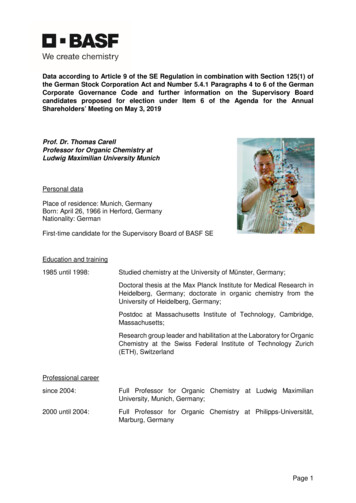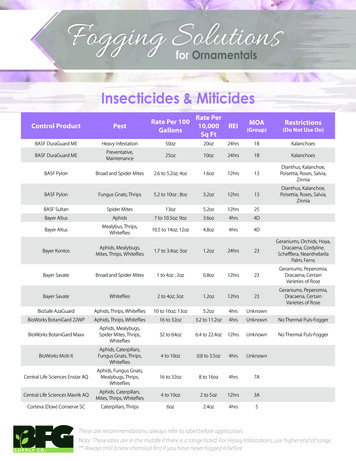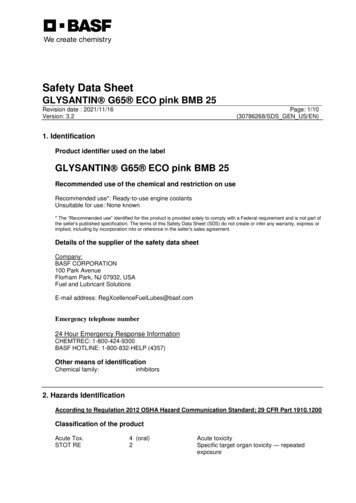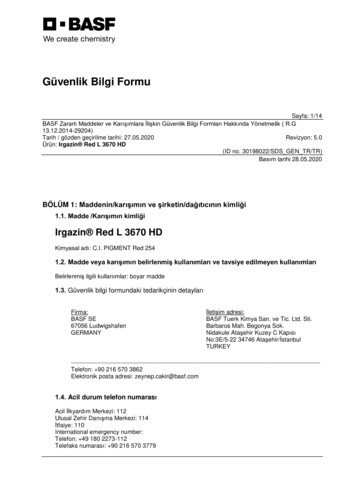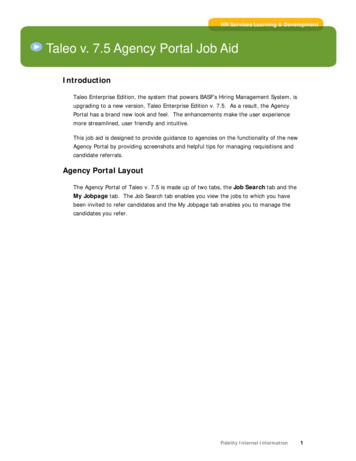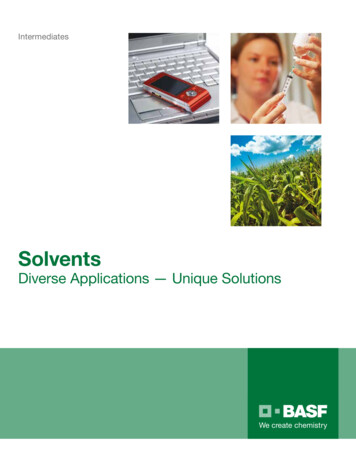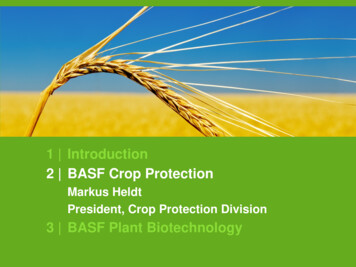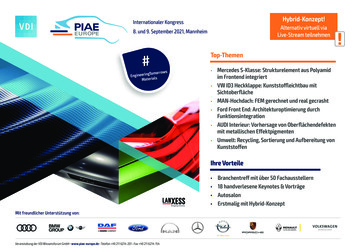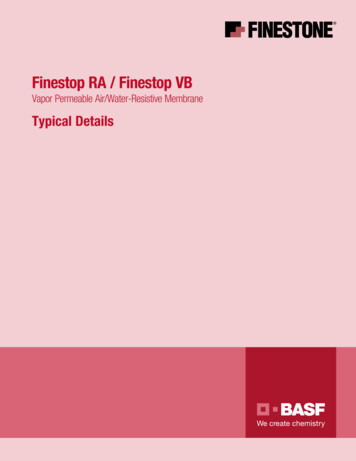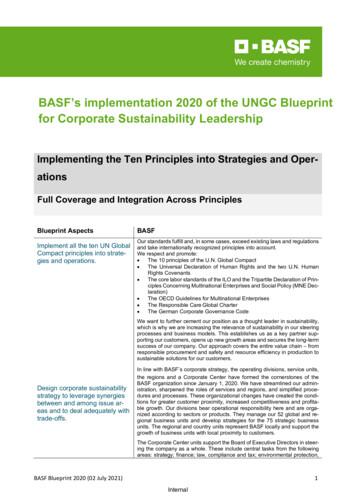
Transcription
BASF’s implementation 2020 of the UNGC Blueprintfor Corporate Sustainability LeadershipImplementing the Ten Principles into Strategies and OperationsFull Coverage and Integration Across PrinciplesBlueprint AspectsImplement all the ten UN GlobalCompact principles into strategies and operations.BASFOur standards fulfill and, in some cases, exceed existing laws and regulationsand take internationally recognized principles into account.We respect and promote: The 10 principles of the U.N. Global Compact The Universal Declaration of Human Rights and the two U.N. HumanRights Covenants The core labor standards of the ILO and the Tripartite Declaration of Principles Concerning Multinational Enterprises and Social Policy (MNE Declaration) The OECD Guidelines for Multinational Enterprises The Responsible Care Global Charter The German Corporate Governance CodeWe want to further cement our position as a thought leader in sustainability,which is why we are increasing the relevance of sustainability in our steeringprocesses and business models. This establishes us as a key partner supporting our customers, opens up new growth areas and secures the long-termsuccess of our company. Our approach covers the entire value chain – fromresponsible procurement and safety and resource efficiency in production tosustainable solutions for our customers.Design corporate sustainabilitystrategy to leverage synergiesbetween and among issue areas and to deal adequately withtrade-offs.In line with BASF’s corporate strategy, the operating divisions, service units,the regions and a Corporate Center have formed the cornerstones of theBASF organization since January 1, 2020. We have streamlined our administration, sharpened the roles of services and regions, and simplified procedures and processes. These organizational changes have created the conditions for greater customer proximity, increased competitiveness and profitable growth. Our divisions bear operational responsibility here and are organized according to sectors or products. They manage our 52 global and regional business units and develop strategies for the 75 strategic businessunits. The regional and country units represent BASF locally and support thegrowth of business units with local proximity to customers.The Corporate Center units support the Board of Executive Directors in steering the company as a whole. These include central tasks from the followingareas: strategy; finance; law, compliance and tax; environmental protection,BASF Blueprint 2020 (02 July 2021)1Internal
Ensure that different corporatefunctions coordinate closely tomaximize performance andavoid unintended negative impacts.health and safety; human resources; communications; investor relations andinternal audit.The Corporate Development unit, which is part of the Corporate Center, hassteered the integration of sustainability into core business activities and decision-making processes since 2020 (see page 21). Global steering of climaterelated matters is also bundled in this unit, such as coordinating measures toreach our climate protection target and steering the target on making ourproduct portfolio more sustainable.The Board of Executive Directors and the Supervisory Board are regularlybriefed on the current status of individual sustainability topics. In addition, theBoard of Executive Directors is informed about sustainability evaluations inbusiness processes, for example, in the case of proposed investments andacquisitions. It makes decisions with strategic relevance for the Group andmonitors the implementation of strategic plans and target achievement. TheCorporate Sustainability Board, which is composed of heads of business andCorporate Center units and regions, supports the Board of Executive Directors on sustainability topics and discusses operational matters. A member ofthe Board of Executive Directors serves as chair.ReferencesBASF Report 2020 Chapter “The BASF Group”, pp. 20-21Chapter “Our strategic action areas”, p. 28Chapter “Integration of Sustainability”, p. 42Robust Management Policies and ProceduresBlueprint AspectsBASFAssess risks and opportunities onan ongoing basis at both enterprise and product level and undertake due diligence to ensure thatthe company identifies any negative impacts caused by its operations and activities.A catalog of opportunity and risk categories helps to identify all relevantfinancial and sustainability-related opportunities and risks as comprehensively as possible. We also systematically assess opportunities and riskswith effects that cannot yet be measured in monetary terms, such as reputational and climate risks. [ ] We use standardized evaluation and reporting tools for the identification and assessment of risks. The aggregation of opportunities, risks and sensitivities at division and Group level using a Monte Carlo simulation helps us to identify effects and trends acrossthe Group.Opportunities and risks that could arise from material sustainability topicscan only rarely be measured in specific financial terms and have an impacton business activities, especially in the medium to long term.We reduce potential risks in the areas of environmental protection, safetyand security, health protection, product stewardship, compliance, supplierrelationships and labor and social standards by setting ourselves globallyuniform requirements. These often go beyond local legal requirements.We verify compliance with these standards through internal monitoringsystems such as global surveys or audits. In 2020, for example, supplierswere audited for sustainability at a number of sites. Our global Code ofConduct was revised in 2020 to which all employees, managers and Boardmembers are required to adhere. It defines a binding framework for ourBASF Blueprint 2020 (02 July 2021)2Internal
activities. The monitoring systems are complemented by grievance mechanisms such as our compliance hotlines.Furthermore, ongoing climate change poses both opportunities and risksfor BASF. As an energy-intensive company, climate-related risks ariseparticularly from regulatory changes, such as in carbon prices throughemissions trading systems, taxes or energy legislation. In addition, BASF’semissions footprint and intensity could lead to a negative perception andreduced appeal among external stakeholders such as customers or investors. We counter these risks with our carbon management measures andby transparently disclosing our positions on and contributions to climateprotection (such as political demands, progress in the implementation ofour climate strategy and how our products help protect the environment)in publicly accessible sources (such as this annual report or on the BASFwebsite) and in direct dialog with external stakeholders.Risks to our production and our supply chain resulting from greaterweather extremes (e.g. storms), highly fluctuating water levels and increased water temperatures are addressed by our risk management inproduction and in procurement. For example, we can no longer rule outextreme low-water situations or heat waves caused by climate change atour Verbund site in Ludwigshafen, Germany. In 2019/2020, we thereforeimplemented a package of climate resilience measures. In addition to climate-related risks, there are also opportunities. Our broad product portfolio includes, among other things, solutions for the circular economy andclimate protection (such as insulation foams for buildings, materials forelectromobility and bio-based products). Increased social awareness offers additional market opportunities for these products. We are workingwith numerous scientific and public organizations and initiatives on solutions for sustainable agriculture that meet economic, ecological, and socialdemands over the long term.Our decentralized specialists use a central decision tree to document reportable sustainability risks within the meaning of section 289b et seq. ofthe German Commercial Code. No reportable residual net risks within themeaning of section 289b et seq. of the German Commercial Code wereidentified for 2020.Develop strategies and policiesspecific to the company’s operating context – as well as scenariosfor the future - and establishmeasurable short, medium, andlong-term goals.We systematically evaluate sustainability criteria, including the effects ofclimate change, as an integral part of decisions on acquisitions and investments in property, plant and equipment or financial assets. In this way, wenot only assess economic dimensions, but also the potential impacts onareas such as the environment, human rights or the local community. Weevaluate both the potential impacts of our activities as well as which effectswe are exposed to.We achieve long-term business success by creating value added for theenvironment, society and the economy. Sustainability is at the core of whatwe do, a driver for growth and value as well as an element of our riskmanagement. That is why sustainability is firmly anchored into the organization as part of governance, compensation systems and business models.Based on our corporate strategy and the global targets derived from this,we steer the sustainability targets (CO2-neutral growth until 2050, 25%CO2 reduction until 2030 and achieve 22 billion in Accelerator sales by2025) as most important key performance indicators. We have establishedthe necessary steering mechanisms and control systems at Group level.Carbon management bundles our global activities to reduce greenhousegas emissions. We use the Sustainable Solution Steering method to manage our product portfolio. To assess the sustainability performance of ourproducts and identify solutions that make a substantial sustainability contribution in the value chain (Accelerator products), we regularly reassessour product portfolio.BASF Blueprint 2020 (02 July 2021)3Internal
In addition to the climate protection and Accelerator sales targets, we havealso set ourselves further sustainability targets on responsible procurement, engaged employees, women in leadership positions, occupationalhealth and safety, process safety and water management.BASF is setting itself even more ambitious goals on its journey to climateneutrality and wants to achieve net zero emissions by 2050. Based on themost recent progress in developing low-emission and CO2-free technologies, the company is also significantly raising its medium-term 2030 targetfor reductions in greenhouse gas emissions: BASF now wants to reduceits greenhouse gas emissions worldwide by 25 percent compared with2018 – and to achieve this despite targeted growth and the constructionof a large Verbund site in South China.Examples of goals: Net zero CO2 emissions by 2050; 25% reduction by 2030 (compared to 2018) Achieve 22bn in Accelerator sales by 2025 Cover 90% of suppliers with sustainability evaluations by 2025 Introduce sustainable water management at all production sitesin water stress areas and at all Verbund sites by 2030Engage and educate employeesthrough training activities, the development and adjustment of business processes, and sound incentive schemes.BASF can rely on the engagement of its employees. Employee engagement is shown by, for example, a passion for the job, a dedication to topperformance and a commitment to BASF. Global employee surveys andpulse checks are an established feedback tool in the BASF Group, andare used to actively involve employees in shaping their working environment. The results are communicated to employees, the Board of Executive Directors, the Supervisory Board and stakeholders. We have performed regular global employee surveys since 2008. We aim to keep theemployee engagement determined by these surveys at a high level andincrease it even further as far as possible. As part of the BASF strategy,we therefore set ourselves the following goal in 2018: More than 80% ofour employees feel that at BASF, they can thrive and perform at their best.We regularly calculate the employee engagement level as an index scorebased on five questions on set topics in our employee surveys. Overall,more than 72,000 employees worldwide participated in this year’s survey,representing 66% of survey recipients.1 The 2020 survey revealed an engagement index of 82% (2019: 79%). Our aim is to keep this score above80%. We support our leaders with a range of follow-up measures to decentrally address individual action areas and in this way, help to furtherstrengthen employee engagement together with their employees.Learning and development are essential success factors for a strong company culture. The skills and competencies of our employees are critical forprofitable growth and lasting success. For this reason, we want to furthermodernize our learning culture and step up our efforts to promote lifelong,self-directed learning. Employee development at BASF is guided by thebelief that talent is in everyone. This means that development opportunities and support are open to all employees. In our understanding, there ismore to development than a promotion or a job change – it encompassesthe development of personal experience and abilities.In regular development meetings, which are held as part of our annualemployee dialogs, employees outline ideas for their individual development together with their leaders and determine specific measures for further training and development, which focus on personal and professionalcompetencies. Our learning activities follow the “70-20-10” philosophy: Weapply the elements “learning from experience” (70%), “learning from others” (20%) and “learning through courses and media” (10%). Our learningBASF Blueprint 2020 (02 July 2021)4Internal
and development offerings cover a range of learning goals: starting a career, expanding knowledge, personal growth and leadership development.Digital learning formats play an important role in our development offerings. Even before the coronavirus pandemic, training for leaders and employees was updated to meet the challenges of the digital transformationand modern working life with appropriate learning formats and content.For example, the Digitalization & Me platform was established as a centralresource where employees and leaders can find a wide range of onlinetraining, learning paths on LinkedIn Learning, or virtual continuous professional development events.We enable our employees to take responsibility for their own professionaldevelopment within the company with digital and novel offerings. To support multidisciplinary teams in the development of products, services orbusiness models, workshops on design thinking empower participants tofind creative and innovative solutions to complex problems. This fostersan agile learning and working culture, which will ultimately also help us tomaster the digital transformation.To harness the opportunities of the digital transformation for BASF, the#liveitleadit initiative for leaders focused on agility in 2020. Over 3,000 participants discussed methods, best practices and insights into agile workingand digital leadership in monthly digital events.In addition, more and more academies in the divisions and service units,which teach specific professional content, offer virtual training. We haveoffered virtual presence training since 2018, which gives all employees theopportunity to attend professional development courses via digital communication channels such as virtual meetings.Implement a system to track andmeasure performance based onstandardized performance metrics.In order to assess the sustainable performance of the Board of ExecutiveDirectors, each year the Supervisory Board sets a target agreement withthe Board of Executive Directors as a whole. The target agreement contains one-year operational targets, primarily earnings, financial and operational excellence targets. This includes, for example, EBIT before specialitems. One-year strategic targets relating to the further development ofBASF, primarily targets for growth, portfolio optimization, investment andR&D strategy, digitalization, sustainability and BASF corporate values.Our data collection methods for environmental protection and safety arebased on the recommendations of the International Council of ChemicalAssociations (ICCA) and the European Chemical Industry Council(CEFIC). In the section “Environmental Protection, Health and Safety,” wereport all data including information on the emissions and waste of theworldwide production sites of BASF SE, its fully consolidated subsidiaries,and proportionally consolidated joint operations.Our reporting is audited by a third party. KPMG AG Wirtschaftsprüfungsgesellschaft has audited the BASF Group Consolidated Financial Statements and the Management’s Report and has approved them free of qualification. The audit of the Consolidated Financial Statements is based onthe likewise audited financial statements of the BASF Group companies.KPMG conducted a reasonable assurance of all disclosures on the mostimportant nonfinancial key performance indicators, accelerator sales andCO2-neutral growth.The NFS disclosures can be found in the relevant sections of the Management’s Report and have been prepared in accordance with the appropriateframeworks: the Global Reporting Initiative Standards (“Comprehensive”application option) and the reporting requirements of the U.N. Global Compact.BASF Blueprint 2020 (02 July 2021)5Internal
We want to measure the value proposition of our actions along the entirevalue chain. We are aware that our business activities have an impact onthe environment and society, and so we strive to increase the positive contribution and minimize the negative effects of our business activities. Toachieve this, we need to continually improve our understanding of how ouractions impact society and the environment. We already have many yearsof experience of this from evaluating our products and processes usingmethods such as Eco-Efficiency Analyses, the SEEbalance Socio-Eco-Efficiency Analysis, our Sustainable Solution Steering portfolio analysis, orBASF’s corporate carbon footprint. BASF also plans to make the individualcarbon footprints for around 45,000 sales products available by the end of2021 with the help of a new, in-house digital solution. PCFs comprise allproduct-related greenhouse gas emissions that occur until the BASF product leaves the factory gate for the customer: from the purchased raw material to the use of energy in production processes (Scope 1–3). Calculating PCFs creates transparency for our customers and partners, enablingus to develop plans together to reduce CO2 emissions along the valuechain up to the end product.We want to understand the value we contribute to society and make thistransparent. This is why we developed the Value to Society approach in2013 together with external experts. It allows us to better understand ourcontribution to a sustainable future. In addition, we can use it to comparethe significance of financial and nonfinancial impacts of our business activities on society and show their interdependencies.ReferencesBASF Report 2020 Chapter “About this report”, p. 6Chapter “Overview”, p. 17Chapter “Status of Target Achievement in 2020”, p. 32Chapter “Integration of Sustainability”, p. 44Chapter “Employees”, pp. 145, 148Chapter “Opportunities and Risks“, pp. 165-166Chapter “Compensation report”, p. 187Further references BASF presents roadmap to climate neutralityBASF Blueprint 2020 (02 July 2021)6Internal
Mainstreaming into Corporate Functions and Business UnitsBlueprint AspectsBASFPlace responsibility for executionof sustainability strategy in relevant corporate functions (procurement, government affairs,human resources, legal, etc.) andensure that no function is operating in conflict with sustainabilitycommitments and objectives ofcompany.Sustainability is at the core of what we do, a driver for growth and value aswell as an element of our risk management. That is why sustainability isfirmly anchored into the organization as part of governance, compensationsystems and business models.Based on our corporate strategy and the global targets derived from this,we steer the sustainability targets (CO2-neutral growth until 2050, CO2 reduction by 25% until 2030 and achieve 22 billion in Accelerator sales by2025) as most important key performance indicators. We have establishedthe necessary steering mechanisms and control systems at Group level.Carbon management bundles our global activities to reduce greenhousegas emissions. We use the Sustainable Solution Steering method to manage our product portfolio. To assess the sustainability performance of ourproducts and identify solutions that make a substantial sustainability contribution in the value chain (Accelerator products), we regularly reassess ourproduct portfolio.Align strategies, goals and incentive structures of all businessunits and subsidiaries with corporate sustainability strategy.Assign responsibility for corporate sustainability implementationto an individual or group withineach business unit and subsidiary.(both sections at the right-handside apply to the three blueprintaspects above)In addition to the climate protection and Accelerator sales targets, we havealso set ourselves further sustainability targets on responsible procurement, engaged employees, women in leadership positions, occupationalhealth and safety, process safety and water management.The Corporate Development unit, which is part of the Corporate Center,has steered the integration of sustainability into core business activities anddecision-making processes since 2020 (see page 21). Global steering ofclimate-related matters is also bundled in this unit, such as coordinatingmeasures to reach our climate protection target and steering the target onmaking our product portfolio more sustainable.The Board of Executive Directors and the Supervisory Board are regularlybriefed on the current status of individual sustainability topics. In addition,the Board of Executive Directors is informed about sustainability evaluations in business processes, for example, in the case of proposed investments and acquisitions. It makes decisions with strategic relevance for theGroup and monitors the implementation of strategic plans and targetachievement. The Corporate Sustainability Board, which is composed ofheads of business and Corporate Center units and regions, supports theBoard of Executive Directors on sustainability topics and discusses operational matters. A member of the Board of Executive Directors serves aschair.ReferencesBASF Report 2020 Chapter “Integration of Sustainability”, p. 42BASF Blueprint 2020 (02 July 2021)7Internal
Value Chain ImplementationBlueprint AspectsBASFAnalyze each segment of thevalue chain carefully, both upstream and downstream, whenmapping risks, opportunities andimpacts.Upstream:Communicate policies and expectations to suppliers and other relevant business partners.Our partnerships with suppliers are based on mutual value creation, as wellas a reliable supply of raw materials, technical goods and services at competitive prices.1 We work together in an open and transparent way to generate long-term benefits for both sides.Our sustainability-oriented supply chain management helps to managerisks. We have defined our standards and processes in global guidelinesand are constantly refining and optimizing these. Our risk-based approachaims to identify and evaluate sustainability risks in our value chains as bestpossible to improve sustainability together with our suppliers. We regularlyreview and document progress based on the risk level. Employees withprocurement responsibility receive ongoing training in sustainability-oriented supplier management and responsible procurement. In 2020, 462BASF employees received such training.Our expectations of our suppliers are laid down in the global Supplier Codeof Conduct. This clarifies for our suppliers the standards to be met andsupports them in carrying out our requirements. We count on reliable supply relationships and want to make our suppliers’ contribution to sustainable development visible to us.We actively promote sustainability in the supply chain and have set ourselves ambitious targets for this: By 2025, we aim to have conducted sustainability evaluations for 90% of the BASF Group’s relevant spend2 andwill develop action plans where improvement is necessary. In addition, weare working toward having 80% of suppliers improve their sustainabilityperformance upon re-evaluation by 2025. In 2020, 80% of the relevantspend had been evaluated. Of the suppliers re-evaluated in 2020, 68% hadimproved. The global targets are embedded in the target agreements ofpersons responsible for procurement.Implement monitoring and assurance mechanisms within company’s sphere of influence.New suppliers are selected and existing suppliers are evaluated not onlyon the basis of economic criteria, but also environmental, social and corporate governance standards. As such, the selection, evaluation and auditing of suppliers is an important part of our sustainable supply chain management. Approaches and responsibilities are set out in a global guideline.Due to the size and scale of our supplier portfolio, our suppliers are evaluated based on risk, including materiality and country and industry-specificrisks. We also use observations from our employees in procurement andinformation from internal and external databases, such as Together forSustainability (TfS) assessments.BASF is a founding member of Together for Sustainability (TfS). The initiative was established in 2011 to improve sustainability in the supply chain.The focus is on standardizing and simplifying supplier evaluations and audits globally. This increases transparency and creates synergies. Suppliersonly have to complete an assessment process once. The results are thenmade available to all TfS members in a database and are mutually recognized – saving time and money for both parties. Suppliers are evaluatedby independent experts either in on-site audits or online assessments. Thelatter are conducted by EcoVadis, a ratings agency specialized in sustainability analyses.BASF Blueprint 2020 (02 July 2021)8Internal
At the end of 2020, TfS had 29 members with a combined procurementspend of around 227 billion. A total of 258 audits and 4,675 online assessments were performed. As a TfS member, BASF itself is assessedand was one of the best-rated companies in 2020. With 80 points in sustainable procurement, BASF is among the top 1% in this category worldwide.Using TfS evaluations, we pursue a risk-oriented approach with clearly defined, BASF-specific follow-up processes. If we identify deviations from ourstandards, we ask our suppliers to develop and implement correctivemeasures within a reasonable time frame. We support them in their efforts,for example by providing training on environmental, social and corporategovernance topics. We trained employees from 43 Chinese suppliers in2020 as part of a partnership with the East China University of Science andTechnology in Shanghai, China.As part of TfS, training was developed for suppliers that already have asustainability rating but have potential for improvement in environmental,social and corporate governance. In 2020, more than 1,000 participantsattended TfS training on this topic in China and Brazil. The TfS SupplierAcademy is also developing training opportunities for our suppliers aroundthe world. These will be implemented in 2021.BASF supports the implementation of initiatives such as the Global ProductStrategy (GPS) of the ICCA. GPS is establishing worldwide standards andbest practices to improve the safety management of chemical substancesand to support governments in the introduction of local chemical regulations. We are also involved in initiatives such as workshops and trainingseminars in emerging markets.We review our suppliers’ progress according to a defined timeframe basedon the sustainability risk identified, or after five years at the latest. In thecase of ongoing, serious violations of the standards defined in our SupplierCode of Conduct or international principles, we reserve the right to imposecommercial sanctions. These can go as far as termination of the businessrelationship. In 2020, this was decided in four cases.Analyze each segment of thevalue chain carefully, both upstream and downstream, whenmapping risks, opportunities andimpacts.Downstream:Undertake awareness-raising,training and other types of capability building with suppliers andother business partners.We maintain and evaluate environmental, health and safety data for all ofour substances and products in a global database. This information is continuously updated. The database forms the basis for our safety datasheets, which we make available to our customers in around 40 languages.These include information on the physical/ chemical, toxicological and ecotoxicological properties of products, potential hazards, first aid measures,measures to be taken in the case of accidental release, and disposal. OurProduct stewardship is of central importance for us. We want to ensurethat our products meet our customers’ quality expectations and pose norisk to people, animals or the environment when used in the manner intended. We are committed to continuously minimizing the negative effectsof our products on the environment, health and safety along the value chain– from development to disposal – and to the ongoing optimization of ourproducts. This commitment to product stewardship is enshrined in our Responsible Care charter and the initiatives of the International Council ofChemical Associations (ICCA). Our aim is to comply with all relevant national and international laws and regulations. Our global requirements define rules, processes and responsibilities, for example, to ensure uniformlyhigh product stewardship standards worldwide. In some cases
gional business units and develop strategies for the 75 strategic business units. The regional and country units represent BASF locally and support the growth of business units with local proximity to customers. The Corporate Center units support the Board of Executive Directors in steer-ing the company as a whole.
